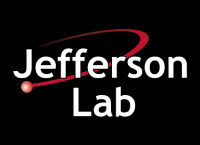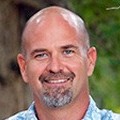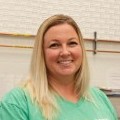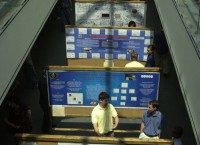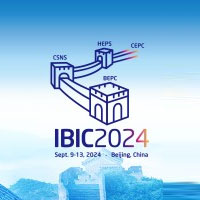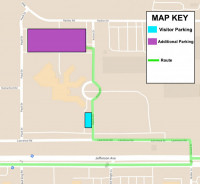From Liberia to America to Achieve Her Dream of Becoming an Architect
As a child, Christine Snetter recalls looking up from playing with her blocks to see her mother standing with contractors, holding building materials in her hands. Her family was building their own home in Liberia, West Africa.
“And she was the one making sure things happened,” Snetter says.
This and other early memories instilled in Snetter the desire to become an architect. Today, as the facilities project manager for Jefferson Lab, a job she has held for 24 years, Snetter notes she never wavered about wanting to become an architect.
“Architecture is the art of design and construction and is about people and their spaces,” Snetter explains. “This job allows me to meet people and to give my all to satisfy the needs of people and give them an environmentally friendly and safe workspace that they come to and enjoy.”
Snetter, one of 11 children, began her education in Liberia and completed high school when she was 16. A family friend who owned an architecture firm took her under his wing and nurtured her talents.
“He was open to having me there,” Snetter says. “He really pushed me to achieve my goals.”
Her intrigue in architecture, led her to register for classes at the University of Liberia where she studied math and physics. When she was 21, she boarded a plane for Rome where she purchased a winter coat and then boarded another plane to America. She was scheduled to begin classes in the architecture program at Howard University. Upon completing the program, Snetter’s mother traveled from Liberia to watch her daughter graduate, a major milestone in realizing Snetter’s professional aspirations.
Decades designing at Jefferson Lab
After college, she accepted positions at various architecture firms in Washington, D.C. But in 1992, the economy hit a snag and Snetter was among many architects laid off at that time.
That’s when she received a phone call from Jefferson Lab, then called the Continuous Electron Beam Accelerator Facility. She had been on the team of architects from D.C. that originally planned and designed the CEBAF accelerator.
“They needed an architect on staff for the projects they had,” Snetter recalls. The phone call thrust Snetter into a range of emotions: thankful for the opportunity to work in a struggling economy, but torn by leaving the metropolitan D.C. area, and moving to what was then a undeveloped area.
“It took me awhile to decide if I wanted to move,” Snetter says. And then, it took her more than a year to decide if she wanted to stay.
But in the two decades since Snetter’s move to Newport News, she has seen the city grow.
After years of living in Newport News, Snetter decided it was time to realize another of her dreams: to build her own home. She and her husband found land in Providence Forge, and she started designing her dream home: contemporary, full of glass, tall ceilings and open stairwells with metal railings.
Managing Projects
At work, Snetter works daily with teams of people to determine the needs of the lab and making them a reality. From hearing the needs to translating them into enjoyable work environments, Snetter assesses, tracks and helps people understand the design processes from concepts to construction.
Snetter’s main job is to manage large and small ongoing projects based on a 10-year plan that is updated annually. These projects take many forms and move at varying speeds.
Larger projects often require years of visualizing and planning with various different teams. Questions such as: Where is the research headed? What facilities will be needed to support such research? What do these facilities need to look like to support the research and the teams?
Once these questions have been answered, proposals must be drafted seeking approval and funding from the Department of Energy.
Smaller projects fall within Jefferson Lab’s annual budget, where money is identified for renovations or smaller buildings, such as Jefferson Lab’s recently updated Data Center or the new Environment, Safety, Health and Quality building.
Part of Snetter’s job is to understand the scope of a project, what exactly is needed, who will be administering construction, and holding reviews at each stage.
Most importantly, she says, her job requires listening.
“You have to be understanding, a good listener, a good communicator,” Snetter points out. “It’s not just hearing people, but addressing what they’re talking about.”
Snetter works with various teams: the scientists, to see what they need; the environmentalists, to ensure that a project follows all regulations; the architect and construction firms, on build outs; the Department of Energy to draft, submit and follow up with proposals as well as checking in on various stages of development and construction.
A Life Dedicated to Building
Snetter who grew up building sandcastles on the beach, memorizing Bible verses and reading every book she could find in libraries, was always taught to follow her dreams.
“We were very innovative,” Snetter recalls. “My mother instilled in us that nothing is impossible. You can do anything. We made things happen for ourselves.”
At work and at home, Snetter applies this fierce dedication to making things happen. Through tough negotiations with scientists, engineers, architects and construction firms, Snetter seeks everyone’s best.
“I like quality work,” Snetter states.
Mother of her daughter, who is a medical doctor, and grandmother to four grandchildren, Snetter describes her life purpose as being a compassionate person who loves giving and being there for people, a mission she feels was influenced by her mother who was always strong, hardworking and loving to the point of taking in foster children while raising her own.
When she isn’t at work, you’ll find Snetter gardening, practicing yoga or volunteering. A previous volunteer with Big Brothers Big Sisters of America, a board member of the Virginia Licensing Board for architects, as well as serving on a committee for university accreditation, Snetter is committed to helping the future of her field.
“I desire to make things better,” Snetter says. “Seeing what a difference I can make.”


